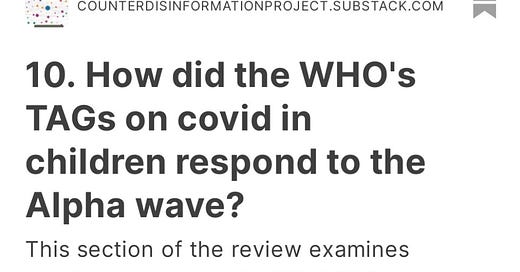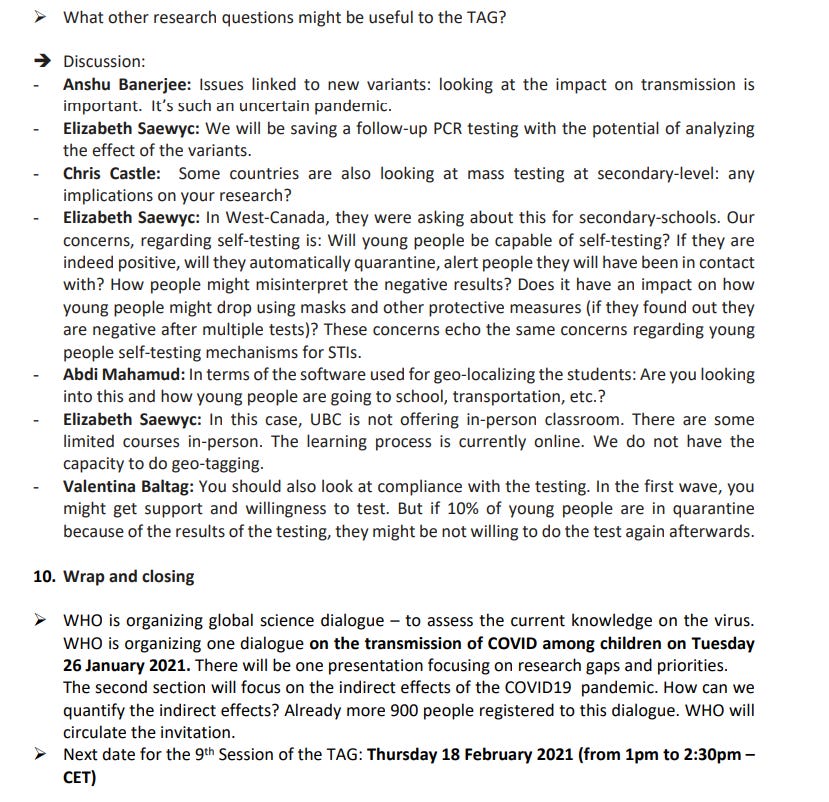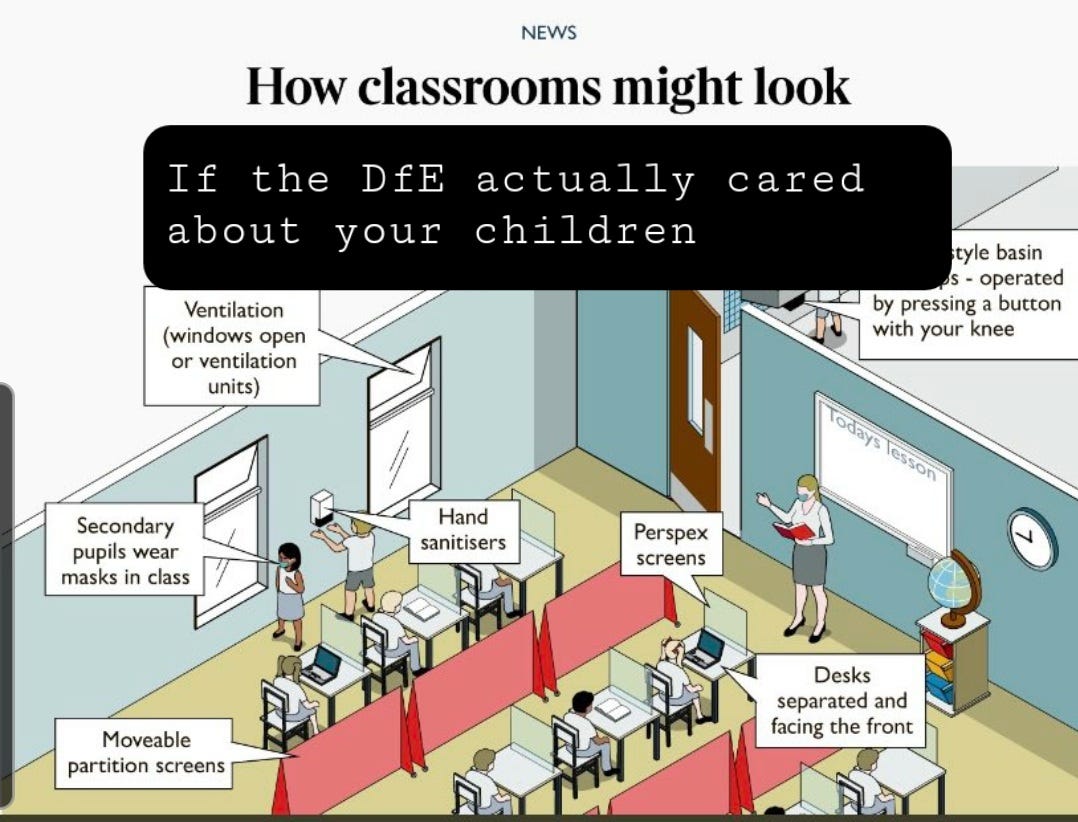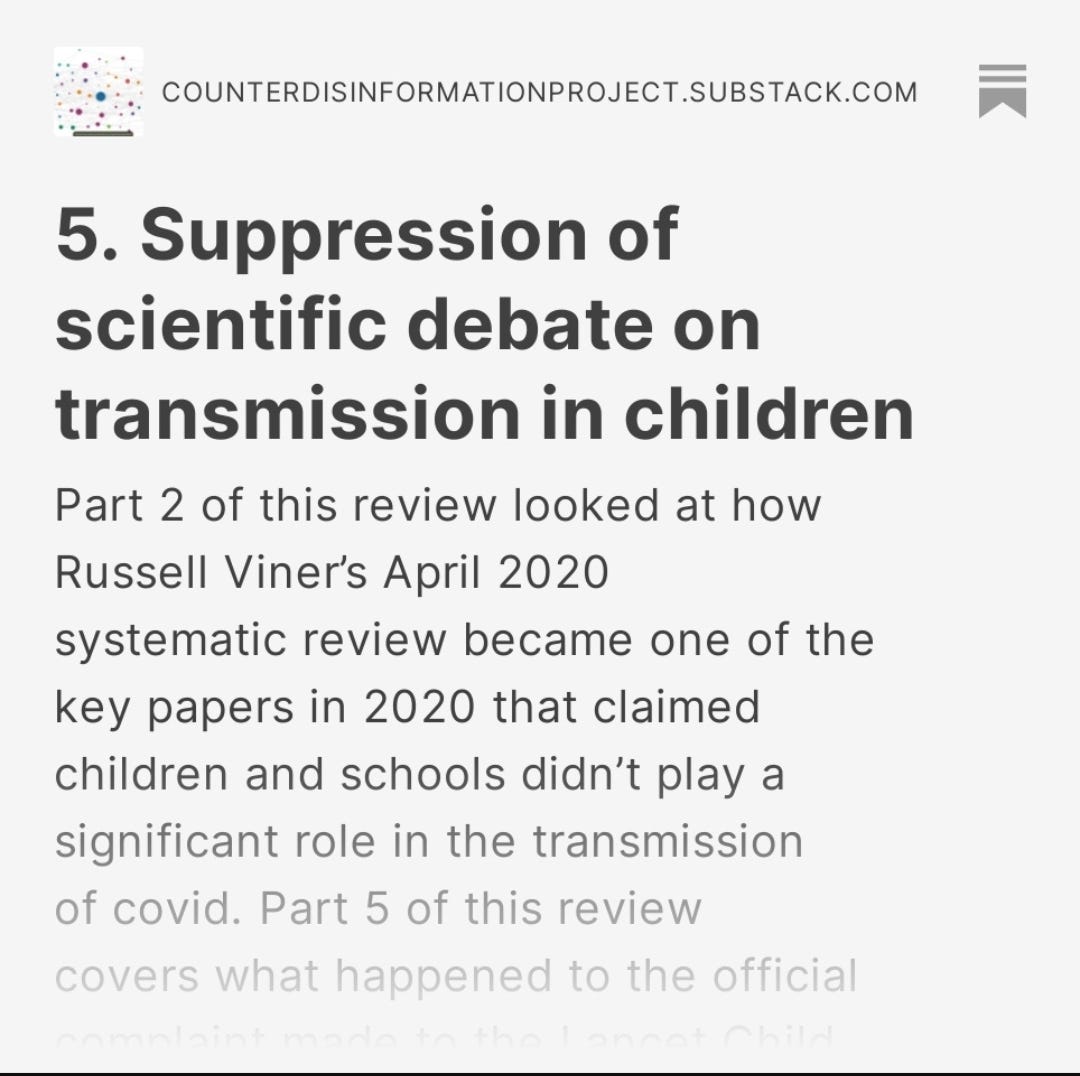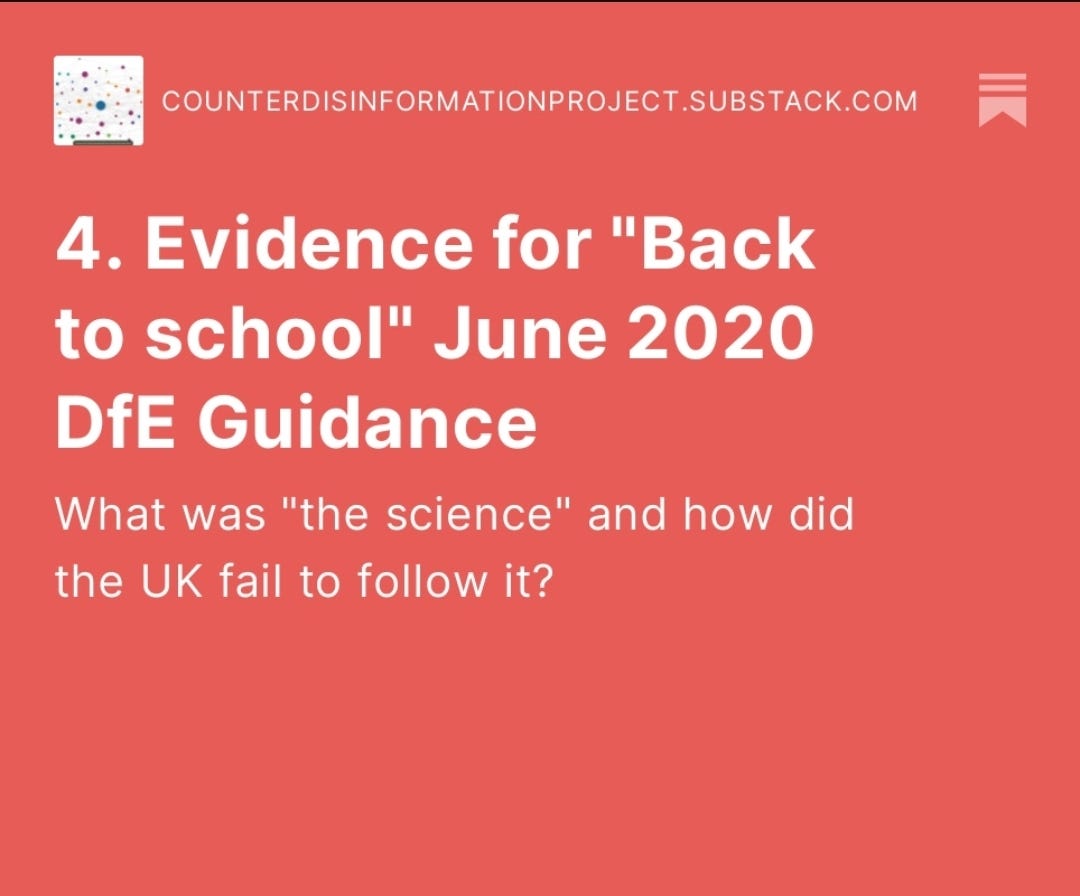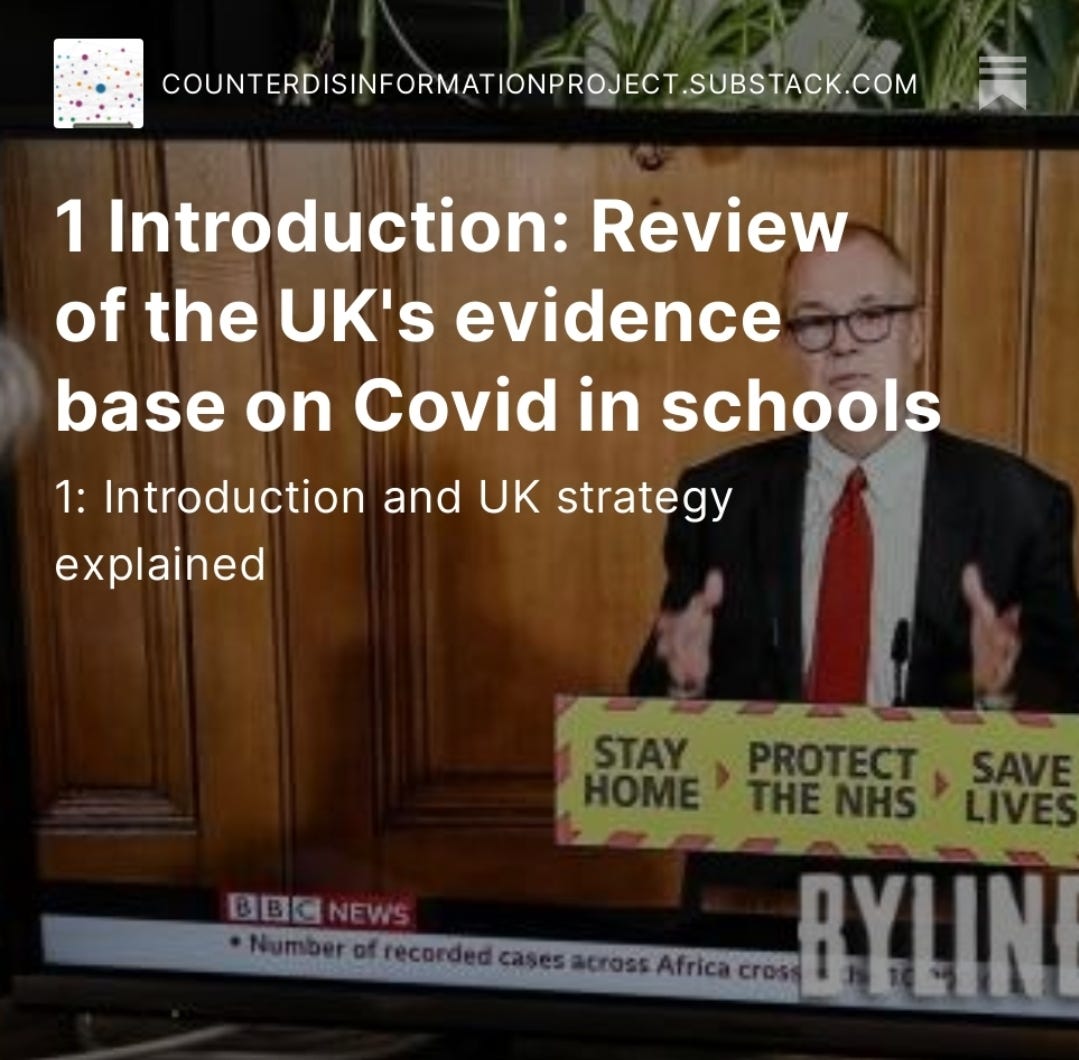10. How did the WHO's TAGs on covid in children respond to the Alpha wave?
While variants emerged around the world, UK members argued against measures
This section of the review examines the discussions had by WHO TAGs as variants were on the rise around the world. Of most consequence was the Alpha variant emerging in the UK which would lead to the UK’s deadliest wave, other variants that emerged in the second wave included Beta in South Africa and Gamma in Brazil.
17 November 2020 Sixth Meeting of the Technical Advisory Group (TAG) of Experts on Educational Institutions and COVID-19
The meeting begins with the presentation of a UNICEF paper that a number of TAG members helped draft. It is essentially the narrative of governments such as Sweden and the UK, designed to inform policy makers that children in schools don't contribute to transmission.
The discussion shows some members questioned the language of certainty in the document considering evidence of increasing prevalence in children at the time, that claims of no evidence was risky considering the potential for proof of transmission emerging later, however it was argued by some that the title was using biased language and the document needed to present a more balanced view so that the conclusion that schools don't contribute to transmission would be more persuasive.
They didn’t want to appear biased, however there was a clear aim to persuade policy makers to adopt their conclusion.
Next the group discussed evidence of the harms of measures.
The matrix of measures based on community transmission were updated, however the annex containing the changes isn’t included in the minutes.
The final item was on studies on the wellbeing of children and young people
Its worth noting that there was no discussion of the first generation of variants that were emerging at the time.
8 December: Second WHO European High-level Meeting on Schooling during the COVID-19
The minutes of this meeting were published in March 2021.
The first foreword by Hans Henri P. Kluge WHO Regional Director for Europe considered the return of students to schools a courageous and positive achievement, suggesting targeted measures in the community would be enough to prevent transmission in schools. This is at a time when many countries were struggling to control transmission with lockdowns being declared or considered across Europe.
Roberto Speranza Minister of Health of Italy’s foreword to the meeting was less positive, his country had required school closures to gain control of escalating transmission.
The introduction states that many measures, not just lockdowns have the potential to seriously affect the education and development of students. Which measures are considered harmful are not mentioned, however its likely this refers to masks and testing. The UK’s paediatric advisers have suggested elsewhere on a number of occasions that any measures could be considered to be creating an atmosphere of fear which impacts students. It could be argued that acknowledgement of a pandemic in schools impacts student well-being, however a lack of protective measures could also impact the health and well-being of students, in particular those from at risk households.
This was followed by some comments from Stefania Giannini, the Assistant Director General of the United Nations Educational, Scientific and Cultural Organization “education is still very much being affected by the pandemic and emphasizes the importance of the collaborative work being taken forward through the TAG, in which UNESCO is an active partner, in supporting ministers and the education community to cooperate with ministries of health to ensure schools can reopen safely to provide continued learning.”
Martin Weber said care need to be taken that measures implemented to control transmission weren’t more harmful to children than covid.
The meeting’s youth representatives, Malika Nakisbekova, Frida Rasmussen and Emilia Carai, then took the floor to describe a project they have created that is investigating the educational, mental health and social effects of COVID-19 restrictions on students
Antony Morgan, Chair of the Technical Advisory Group and Professor in Public Health at Glasgow Caledonian University, United Kingdom, explained that the overall objective of the TAG’s work is to deal with the here and now, and to ensure that young people’s health and education is as unaffected and uninterrupted as possible, while their safety is secured.
Next come a number of updates from several members on the situation in their countries.
Germany: schools didn’t drive transmission but case and outbreaks had increased with schools reopening meaning preventative measures were considered important, particularly testing.
Denmark: Very similar to the UK “Social distance of one metre should be kept, except within the classroom, and hand washing, general hygiene and cleaning of common contact points remain essential.” Students over 12 were expected to wear masks on the bus while teachers and staff were permitted to wear a visor in class. There were school closures at local level at the advice of health authorities.
Expecting masks on the bus and social distancing outside the classroom but not inside classrooms is theater not public health, giving the impression of tackling transmission while ignoring where students spend more than five hours of the school day. The argument that masks cause considerable disruption to education was cited in the UK, so the essential question is does masking cause more disruption than infections? It seems unlikely, looking at DfE data it appears infections are a major source of disruption
Armenia : Reduced class sizes, compulsory masks for ages 6+, school closures if 10% or more are infected, and many other measures.
Croatia: Three tiers in operation, full schooling with some measures, rotas, and distance learning.
France: Masks for ages 6+ “The new strategy aims to improve academic success and limit economic impacts of disrupting children’s education, which was particularly hard on the most disadvantaged children. The government has been determined to keep schools open if at all possible.”
Then follows a number of technical updates.
WHO guidance is to try and keep schools open even when there is high transmission and no additional health system capacity available. This is a large gamble on schools not contributing to transmission considering rising cases across Europe and new variants.
Ladhani discussed schools correlating to community transmission, this appears to be based on the schools infection study he leads. The survey samples school populations, but only those in school on the day, those isolating due to testing positive or as contacts were not included. To be covered in more detail at a later date.
There is one of the only mentions of ventilation in a WHO meetings, as ventilation quality is hard to judge masks should be considered. The UK was particularly resistant to masks in schools compared to much of Europe.
Viner reviewed recent studies concluding that when schools get measures right there is little evidence of transmission.
However what measures did Viner think were necessary? In the run up to this meeting he had argued against rotas to reduce class sizes and contacts, had said that too many children were being testing and said there wasn’t sufficient evidence on mask use in schools. After this meeting he supported schools returning in the midst of the Alpha wave in January without many of the measures other countries had already put in place beforehand.
Was Viner arguing at the WHO meeting that effective measures were minimalist or was he arguing against measures in the UK media knowing this would lead to higher transmission in schools?
Other presentations include rapid testing, immunisation programmes for other diseases, proposals for a Cochrane review on measures in schools.
16 December: Seventh Meeting of the Technical Advisory Group (TAG) of Experts on Educational Institutions and COVID-19
Context for this meeting: This was the last week of the school term for most state schools in the UK before the Christmas holidays. Many schools were already closed or partially closed due to large scale outbreaks across year groups or a lack of staff. The Alpha variant had been identified and two days before the Department for Education had threatened Greenwich council with court action to reopen its schools for three more days after the council made the decision to protect its community from rapidly rising infection rates. The DfE’s plan was for all students to return to school in just over two weeks time with the only additional measure being the introduction of rapid testing, schools were told not to recommend masks. The UK advisers who were members of the WHO TAG’s supported this approach. A month later the UK would record the highest death tolls of the pandemic. Many thousands would be hospitalised, and many thousands with initially mild symptoms would go on to develop long covid.
The meeting begins with a discussion after a presentation on current projects. With vaccines being approved the focus is on returning to normal, tacking covid related mental health stress and anxiety.
Whilst schools were closing due to lack of teachers and schools were making up around 40% of outbreaks the TAG concluded there was little evidence schools staff were at higher risk, although they don’t specify if they mean not at higher risk of being infected or not at higher risk once infected.
They suggest helping teachers with cleaning, PPE and posters. No mention of clean air is mentioned in the meeting notes. The concern for teachers is in regards to their mental health when isolating, the WHO thought a lack of teachers would result in class sizes being doubled rather than students being sent home.
Burn out and stress are considered definite issues.
There is a long discussion on access to school nurses in different countries.
Next there is a discussion on the implications of vaccination. This begins by stating the role of children in transmission is not fully understood and again there is the statement that education workers are not at higher risk. The focus is on prioritising and vaccine equality.
Finally the research network provides an update.
The precarious situation in the UK with the Alpha variant that was about to sweep across much of the world doesn’t feature as a topic discussion. Its worth noting that other variants such as Gamma in Brazil and Beta in South Africa have also not featured in the TAG’s meetings.
21 January: Eighth Meeting of the Technical Advisory Group (TAG) of Experts on Educational Institutions and COVID-19
Context: The UK was in lockdown, the daily death toll had reached record peaks of over 1300, around 9,000 people died in the week of this meeting, roughly 40,000 were being treated in hospital. In the US the total death toll surpassed 410,000 deaths.
First presentation.
The results of a poll of TAG members’ priorities are presented.
The discussion that follows considers how the TAG can do more to support programme development, there are concerns that their recommendations are arriving too late. They seem to think this is a problem with process, however there is no acknowledgement that they failed to address the Alpha variant at the previous meeting.
Its worth noting the TAG’s key focus is keeping schools open.
There is a discussion on if schools would be used as vaccination centres and on the feasibility of rapid testing in universities.
Variants are finally mentioned in the last discussion, this is in regards to transmission but not severity which is a mistake as Alpha was more severe as was Delta which emerged a few months later before gaining global dominance.
18 February: Ninth Meeting of the Technical Advisory Group (TAG) of Experts on Educational Institutions and COVID-19
Context: This is around the time UK schools were returning to full compulsory attendance. Masking was introduced for the first time in secondary schools and would remain in place for about 40 days. Rapid testing twice a week was also introduced in secondary while primary and early years had no measures except bubbles. Data was available to show Alpha was more severe than the Wuhan strain and showed there had been a rise in child hospitalisations over the winter.
The WHO’s focus was on doing everything possible to keep children in school.
A presentation from South Africa concluded schools had no relationship to increased cases and that there was no increase in severity with the new variants. At the time South Africa was weathering the Beta variant. Masks were used widely in schools, despite this over 2000 educators had died. South Africa considered teachers to be a priority for vaccination, a view which wasn’t shared by the UK.
Viner’s presentation focused on the impact of school closures, and the harms of measures. This seems to contradict previous statements in the meeting that stressed the importance of using measures to keep schools open. Viner appears to argue that a level of transmission must be tolerated to keep schools open. At the time he was appearing in the UK media calling for masks to be removed, however there is no acknowledgement that the removal of measures was likely to lead to increased transmission resulting in increased disruption to education.
This is a reoccurring theme particularly with those from the UK, transmission in schools is considered to not be an issue, either because of claims it wasn’t occurring or that transmission didn’t lead to negative impacts. While claiming that loss of education is the greatest detriment to health there is no discussion regarding long covid.
There is a claim that nearly all studies show broad documented harm from school closures, the majority of studies from the UK on this subject were authored by RCPCH colleagues of Viner, while they show adverse impacts on children they provide correlation but do not prove causation.
Baltag and Ladhani lead the final presentation. Antibodies are lower in students than in teachers, however there are more outbreaks in students than in teachers. Ladhani conclude that this shows asymptomatic cases aren’t driving infections in schools, he doesn’t mention a study he authored which showed 25% of children don’t sero-convert, a point made by another TAG member in an earlier meeting.
Summary
The impact of covid on children is discussed almost entirely around the harms of lockdowns and measures. There is a clear group think that infections in children do not cause harm, those deaths that do occur in children are not seen as worthy of trying to prevent and long covid isn’t even mentioned. By this point in the pandemic thousands of children were already suffering from long covid just in the UK.
While some TAG members approved of masks in schools the UK contingent were focused on arguing that the harms were greater. The world was going into lockdown, schools were closing as new variants emerged and yet there still wasn't a discussion on the potential benefits of ventilation and filtration, schools were seen as separate to the rest of the pandemic, they were thought to be impacted by what was going on in the community, however the dominant thinking was that schools didn't impact the community.
9. June - Oct 2020: UK influence on WHO Schools groups
Previous parts of this review of the evidence base behind the UK’s policy on covid in children and schools have examined how the few individuals who became the UK’s key paediatric advisers have sought to influence the evidence base and policy of other countries, for instance the US via email exchanges with Fauci to set up colloboration projects and with…
8. Autumn 2020: How contact testing in UK schools collapsed
COUNTER DISINFORMATION PROJECT
·
21 MAY
7. Why did the UK ignore calls for a September circuit breaker?
13 May
6. Who wrote the September 2020 schools guidance?
COUNTER DISINFORMATION PROJECT
·
26 APR
5. Suppression of scientific debate on transmission in children
COUNTER DISINFORMATION PROJECT
·
16 APR
4. Evidence for "Back to school" June 2020 DfE Guidance
COUNTER DISINFORMATION PROJECT
·
13 APR
3. UK Influence: Viner, Farrar, Fauci emails & ESPID
COUNTER DISINFORMATION PROJECT
·
9 APR
2. March - April 2020 "No child is known to have passed on Covid-19 to an adult"
COUNTER DISINFORMATION PROJECT
·
3 APR
1.Introduction: Review of the UK's evidence base on Covid in schools
COUNTER DISINFORMATION PROJECT
·
30 MAR

